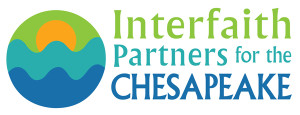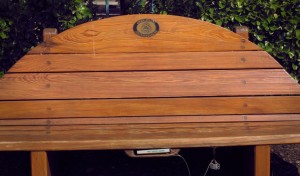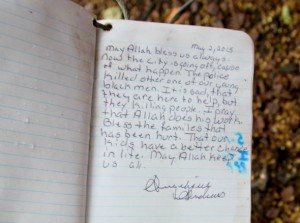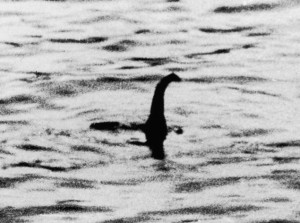Two Organizations Doing Important Work- IPC and Nature Sacred.


 I subscribe to these organization’s emails.
I subscribe to these organization’s emails.
Monday’s email from the Interfaith Partners for the Chesapeake (IPC) included a letter to Virginia Gov. Terry McAuliffe who is the current Chair of the Chesapeake Executive Council. Among the Council’s responsibilities is advocating for and implementing the Chesapeake Clean Water Blueprint, the regional plan to restore the Bay. If you’re not familiar with the Blueprint and you live in the Chesapeake Bay watershed, the next thing you need to consider is reviewing it here. A court victory about a month ago upheld the Plan.
Even if you don’t live in one of the 6 watershed states surrounding the Bay, its important to know that the Plan sets a model for other major watersheds across our land. Religious leaders and other faith-based organizations in support of the Plan ask in the email the rhetorical question of why the Plan matters to them:
“The answer is simple. Until we heal the Earth, we cannot heal ourselves. Until we love the Earth, we will not love each other. Until we honor the sacred waters that connect us all to each other, we will continue to disrespect those downstream of us and those who will walk in our footsteps for generations to come. As Wendell Berry eloquently said, ‘Do unto those downstream as you would have those upstream do unto you.’ Loving each other is the fundamental tenet of all faiths. Loving each other by respecting the Earth is the natural extrapolation of this.”
This answer should go way beyond any potential “confines” of those who have religious faith (like me). For those of you unsure or sure you don’t, doesn’t this quote make sense on some level anyway? Isn’t it something all of us should/can strive for? What’s the good of shooting supposedly protected lions in African parks? A question like this should lead to hundreds of others about vainglory, prejudice and violence; easy.
 The work of Nature Sacred is nearly astounding. From its website: “Our Approach: Sowing the seeds for a deeper understanding of the power of nature as a healing space for individuals and communities.” Its healing places are in many locations around the Mid-Atlantic region–hospitals, prisons, schools and urban neighborhoods/deserts. Often incorporated into the designs is a labyrinth. Always incorporated is a bench, made of 100-year-old pickle barrel wood by inmates learning carpentry skills under the auspices of Maryland Correctional Enterprises. There are now more than 130 of these healing/right-minding installations. A beautifully rendered book about them can be ordered here. (I have a copy in my library which I turn to with surprising frequency.)
The work of Nature Sacred is nearly astounding. From its website: “Our Approach: Sowing the seeds for a deeper understanding of the power of nature as a healing space for individuals and communities.” Its healing places are in many locations around the Mid-Atlantic region–hospitals, prisons, schools and urban neighborhoods/deserts. Often incorporated into the designs is a labyrinth. Always incorporated is a bench, made of 100-year-old pickle barrel wood by inmates learning carpentry skills under the auspices of Maryland Correctional Enterprises. There are now more than 130 of these healing/right-minding installations. A beautifully rendered book about them can be ordered here. (I have a copy in my library which I turn to with surprising frequency.)
 Reminding us of what a bench can be, here’s a definition from Nature Sacred’s website: “[It’s a] place of respite that invites one to pause and reflect. More than just a place to sit, the presence of a Bench in an Open Space Sacred Place is an invitation to pause on one’s journey – to sit, to rest, to breathe, to be present, to experience all the gifts that an Open Space Sacred Place has to offer.”
Reminding us of what a bench can be, here’s a definition from Nature Sacred’s website: “[It’s a] place of respite that invites one to pause and reflect. More than just a place to sit, the presence of a Bench in an Open Space Sacred Place is an invitation to pause on one’s journey – to sit, to rest, to breathe, to be present, to experience all the gifts that an Open Space Sacred Place has to offer.”
Attached to the underside of each bench is a yellow journal in plastic sheathing to keep it dry. Right is a page from a journal at a bench in Sandtown (urban desert), Baltimore. All entries are collected and transcribed. They also stimulate entries by others reading of the pain, trauma, stillness or joy of others who’ve written previous entries.
In the more recent years, the foundation has aimed to help substantiate that nature offers humans healing health and wellness. At a total cost of $4.5M, it has funded 6 very special projects in urban places around the country where the population is in need. Several of these include money earmarked for human biometric research, including one I’ve blogged about previously, the Green Road Project at Walter Reed National Military Medical Center, Bethesda, MD.
From the Founders’ letter: “These studies now underway will investigate individual outcomes (such as stress reduction, emotional healing, attention restoration, and personal resiliency) and the related consequences in the individual’s life context (such as household relations, learning and school performance, work productivity and satisfaction, and community cohesion) of time spent in nearby nature.”
What a journey for the Founders these nature sacred places have been since their vision was first conceived in a pocket park in London! And, through it, they’re so humble about how fantastically the open spaces sacred places have been received. My favorite is one at a very private, former Native American site very near but remote from the CBF HQ building in Annapolis. The long-ago history of the site’s selection and use is a good share of the story of the installation there.
Post Script– The President’s Clean Power Plan, just released, is a temptation for blogging about. But, the Plan has been saturated through the media during the past couple of days. Also, I’ve written about air pollution and jobs, and the number of coal-fired plants and GHG emissions in Maryland and Virginia.
P.P.S. Your blogger will be away, way away for a couple of weeks. Posting will resume late in the month, likely with a new post published first as a commentary elsewhere.
